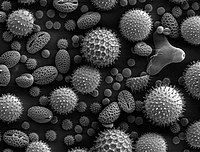
Photo from wikipedia
The organelle-like structures of Xanthomonas citri, a bacterial pathogen that causes citrus canker, were investigated using an analytical transmission electron microscope. After high-pressure freezing, the bacteria were then freeze-substituted for… Click to show full abstract
The organelle-like structures of Xanthomonas citri, a bacterial pathogen that causes citrus canker, were investigated using an analytical transmission electron microscope. After high-pressure freezing, the bacteria were then freeze-substituted for imaging and element analysis. Miniscule electron-dense structures of varying shapes without a membrane enclosure were frequently observed near the cell poles in a 3-day culture. The bacteria formed cytoplasmic electron-dense spherical structures measuring approximately 50 nm in diameter. Furthermore, X. citri produced electron-dense or translucent ellipsoidal intracellular or extracellular granules. Single- or double-membrane-bound vesicles, including outer-inner membrane vesicles, were observed both inside and outside the cells. Most cells had been lysed in the 3-week X. citri culture, but they harbored one or two electron-dense spherical structures. Contrast-inverted scanning transmission electron microscopy images revealed distinct white spherical structures within the cytoplasm of X. citri. Likewise, energy-dispersive X-ray spectrometry showed the spatial heterogeneity and co-localization of phosphorus, oxygen, calcium, and iron only in the cytoplasmic electron-dense spherical structures, thus corroborating the nature of polyphosphate granules.
Journal Title: Micron
Year Published: 2021
Link to full text (if available)
Share on Social Media: Sign Up to like & get
recommendations!